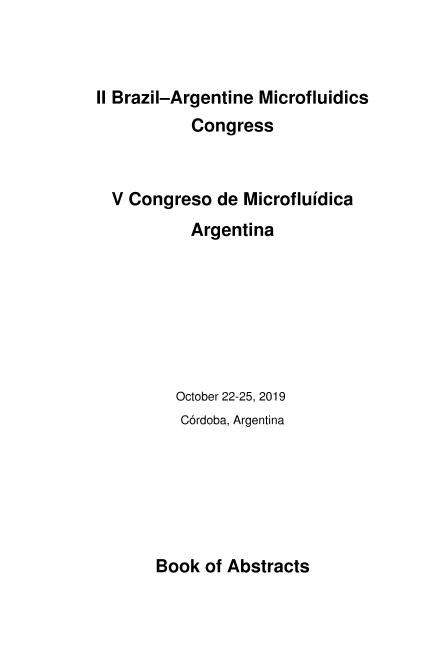Evento
Shock electrodialysis phenomenon for sustainable separation devices through a fluidic system
Montes, Paula; Trejo González, José Adolfo ; Aráoz, María Emilse
; Aráoz, María Emilse ; Pérez, Sofia; Trujillo, Matias; Madrid, Rossana Elena
; Pérez, Sofia; Trujillo, Matias; Madrid, Rossana Elena ; Avila, Adolfo María
; Avila, Adolfo María
 ; Aráoz, María Emilse
; Aráoz, María Emilse ; Pérez, Sofia; Trujillo, Matias; Madrid, Rossana Elena
; Pérez, Sofia; Trujillo, Matias; Madrid, Rossana Elena ; Avila, Adolfo María
; Avila, Adolfo María
Tipo del evento:
Congreso
Nombre del evento:
II Brazil-Argentine Microfluidics Congress; V Congreso de Microfluídica Argentina
Fecha del evento:
22/10/2019
Institución Organizadora:
Universidad Nacional de Córdoba. Facultad de Matemática, Astronomía, Física y Computación;
Título del Libro:
Book of Abstracts: II Brazil-Argentine Microfluidics Congress and V Congreso de Microfluídica Argentina
Editorial:
Universidad Nacional de Cordoba
Idioma:
Inglés
Clasificación temática:
Resumen
The availability of biomass associated with agroindustry residues provides enormous opportunities for new bioproducts applications for sustainable processes. Biochar is a cost-effective carbonaceous material which can serve as raw material to create new separation agents and microdevices for gas purification, water treatment, biomolecule separation, controlled drug delivery, electrochemical reactors, microseparators and many other advanced applications. In this work, we used biochar disks derived from biomass harvest residues as a porous media to study the shock electrodialysis phenomenon in a home-made cell for continuous electrolyte flow of 2 mL in volume. The cell includes two stainless steel electrodes to study this phenomenon (Fig.1). Comparative cyclic voltammetry measurements were performed using the cell in batch mode with 0.1 mM KCl solution either including or not including the biochar porous media. The difference between both voltammetry profiles showed the additional diffusion limitation of the current density provided by the porous material. A set of continuous flow runs considering 0.1 mM KCl solution (~17 µS/cm) were performed under an applied electric potential ranging from 0.2 to 5.0 V and different flow rates between 0.1 to 10.0 mL/min. The continuous monitoring of the solution ion conductivity in the cell outlet throughout each run provided important insights. The decrease of the outlet ion conductivity when the electric potential was applied to the cell indicated the presence of ion concentration polarization through the biochar porous material. The polarization effect increased when flow rates and electrolyte concentrations were lower. Much sharper conductivity drops were observed for flows in the order of 100 µL/min (Fig. 2). Miniaturized systems could be applied in tissue or organ engineering for fluids treatment. With a proper engineering design and scale (geometry, thickness and morphology) and considering optimized operating conditions (flow rate, applied voltage and ion concentration), this cost-effective carbonaceous material may play an important role in the development of new separation technologies for water treatment.
Archivos asociados
Licencia
Identificadores
Colecciones
Eventos(INQUINOA)
Eventos de INST.DE QUIMICA DEL NOROESTE
Eventos de INST.DE QUIMICA DEL NOROESTE
Citación
Shock electrodialysis phenomenon for sustainable separation devices through a fluidic system; II Brazil-Argentine Microfluidics Congress; V Congreso de Microfluídica Argentina; Cordoba; Argentina; 2019; 154-155
Compartir



